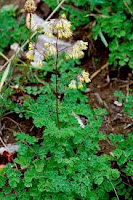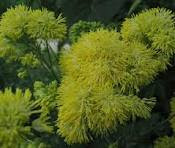The three meadow rues which are native to the British Isles are Thalictrum flavum, Common meadow rue, or Yellow meadow rue, Thalictrum aquilegifolium, Columbine or Greater meadow rue and Thalictrum minus the small meadow rue. They are not related to the herb rue which is a member of the Rutaceae family, but these are in the Ranunculaceae or buttercup family which makes them relatives of the lesser celandine, stinking hellebore, the Christmas rose, wood anemone, stavesacre, wolfsbane, monkshood, goldenseal and black cohosh.
 |
| small meadow rue |
The young leaves of this meadow rue can be cooked and eaten like spinach, although some of the Ranunculaceae family members have some toxicity so caution is recommended. Some research has been done on this plant and some new alkaloids and other compounds have been discovered in it. An infusion of the leaves or a decoction of the root has been used in traditional medicine in the past to help reduce fevers
 |
| common meadow rue |
“Government and virtues. Dioscorides saith, That this herb bruised and applied, perfectly heals old sores, and the distilled water of the herb and flowers doth the like. It is used by some among other pot-herbs to open the body, and make it soluble; but the roots washed clean, and boiled in ale and drank, provokes to stool more than the leaves, but yet very gently. The root boiled in water, and the places of the body most troubled with vermin and lice washed therewith while it is warm, destroys them utterly. In Italy it is used against the plague, and in Saxony against the jaundice, as Camerarius says. A poultice made of the leaves has been known to give ease in the sciatica; and the country people in Buckinghamshire boil the roots and young leaves in ale, and take it as a purge. In smaller doses it works by urine, and removes obstructions of the viscera.”
 |
| greater meadow rue |
As you can see from the pictures, these three meadow rues are quite distinctive, although all are in the same genus.This last has been used in Chinese medicine for the treatment of respiratory problems such as asthma, in combination with other herbs.



No comments:
Post a Comment